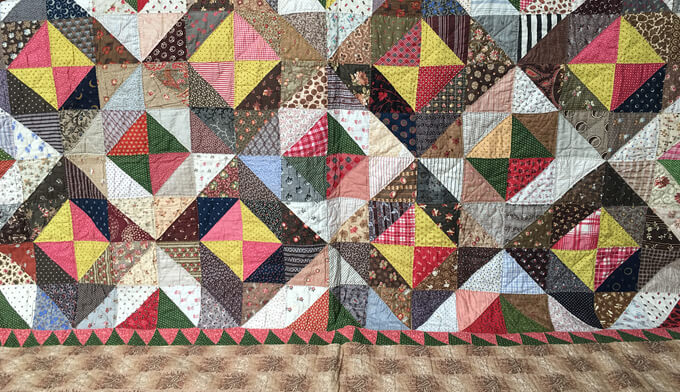
For the last few months, I have been sharing with you some of the quilts from my antique charm quilt collection. I have told you that one of the easiest ways to work with them is to create a unit and then use the same value placement in each block. But many quiltmakers experimented with other layouts of the pieces in ways to showcase each of the different fabrics. The quilt at the beginning of this newsletter is one example.
Quite a few of my charm quilts have radiating rings going from the center outwards. The right triangle in last month’s quilt can be used for these radiation ring designs as well. In this first one, it appears that the maker separated the pieces into lights and darks and then, depending on how many of the two groups there were, added the pieces one row at a time. The first ring is dark, then one ring of light, three of dark, one of light, two of dark and so on.

The maker of the second quilt has not only organized the pieces by light and dark but by color as well. Single rows of lights and darks have been alternated but the rings follow a color pattern as well. I like the way the red pieces in the center balance with the red ring further out. The same holds true with the dark blues.

An equilateral triangle has been used for the radiating rings in this next quilt. The rings are alternated lights and darks. The lightest fabrics are used in the center ring with the fabrics in each successive “light” ring being darker.

I love to look at the individual fabrics in a charm quilt and see what the maker had in mind. In this particular quilt, there are some very interesting fabrics that have been used. One of them is a “cheater” panel that was printed in the 1850’s. I don’t know if all of the cat and dog motifs in this quilt are from the same panel or more than one. But the maker felt because there were different motifs, it could be part of the “charm.” The other fabrics seem to indicate that this quilt was completed in the 1880s.




In this fourth quilt, the charm pieces are hexagon fabrics. Once again, the fabrics were sorted into lights and darks and then by color. The maker had very few green fabrics and I like the way they were arranged in the fourth ring from the center. Likewise, all the pink fabrics form one of the rings. Of particular interest to me is that there are a lot of striped fabrics in the quilt. A close examination shows that all of those fabrics have the stripes oriented in the same direction.

Which of these do you like best?



















































